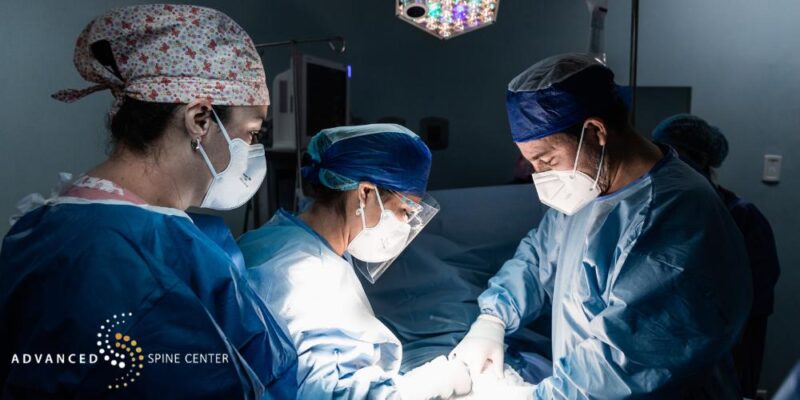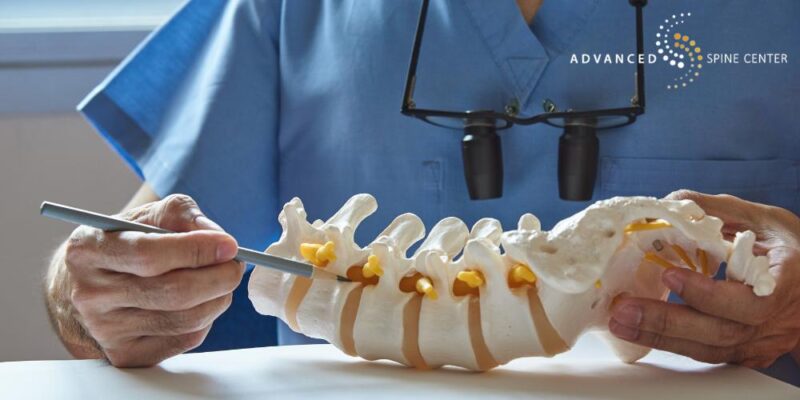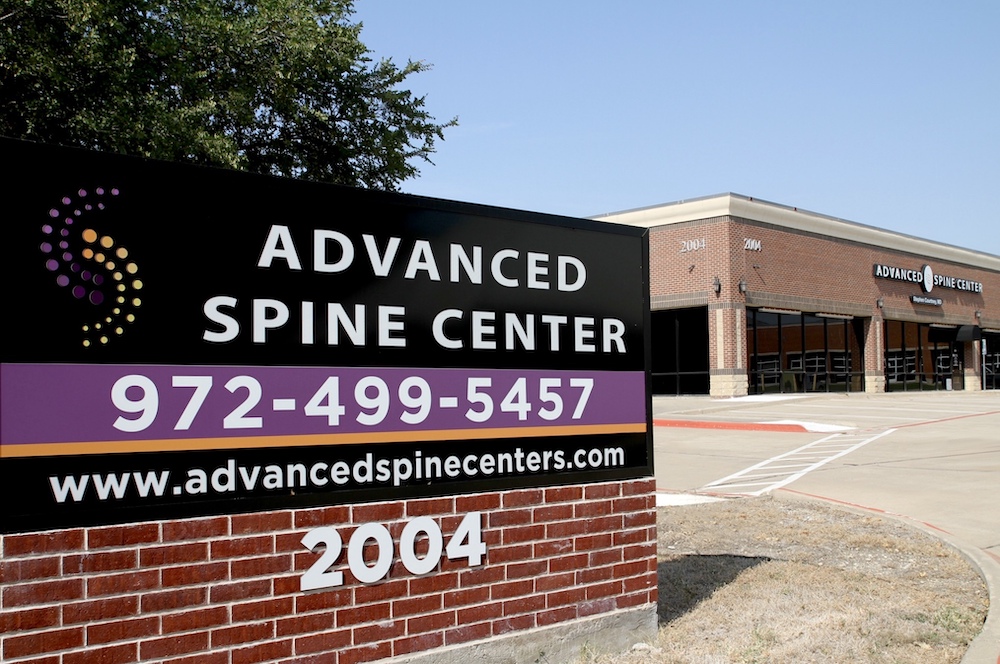Specialties
Minimally Invasive Lumbar Spine Surgeon in Plano, TX
Lower back pain and numbness in your legs can prevent you from doing your favorite activities. However, undergoing minimally invasive lumbar spine surgery (lumbarMIS) under the steady hands of Stephen Courtney, MD, could be your solution. If more conservative treatments have failed to alleviate your pain, surgery may be the best option for you.
At Advanced Spine Center in Plano, Texas, Dr. Courtney brings more than 20 years of experience to patient care for excellent outcomes without the stress of invasive open surgery. Explore the benefits of minimally invasive surgery and schedule a consultation at Advanced Spine Center today by calling 972-499-5457 or booking a consultation online.
What Is Minimally Invasive Surgery?

Minimally invasive surgery (MIS) refers to a surgical approach that utilizes specialized instruments and techniques to perform minimally invasive spine procedures with less damage to the body compared to traditional open surgery.
The primary goal of minimally invasive spine surgery is to achieve the same therapeutic outcomes as open surgery while minimizing trauma to the patient’s body, reducing pain, shortening recovery times, and decreasing the risk of complications.
The key features of minimally invasive spine surgery compared to traditional open surgery include the following.
- Smaller incisions
- Faster recovery
- Endoscopic techniques
- Reduced tissue dissection
- Video guidance
- Minimal scarring
- Shorter hospital stays
What Types of Minimally Invasive Lumbar Surgeries Are Available?

Minimally invasive techniques are offered as an alternative to open surgery. Rather than making a large incision and causing more damage to the body, minimally invasive techniques mitigate this damage.
Dr. Courtney offers two minimally invasive lumbar spine surgery (lumbar MIS) options: MIS lumbar microdecompression and MIS transforaminal lumbar interbody fusion. Below, we outline those minimally invasive procedures, as well as other common MIS lumbar surgeries.
Minimally Invasive Lumbar Decompression
When a patient suffers from a herniated or bulging disc, it can place pressure on the nerve roots in the spinal canal. This pressure can lead to pain and discomfort in the lumbar region of the spine. A minimally invasive lumbar decompression is done to create more space in the spinal canal for the spinal cord and spinal nerves.
By removing a portion of bone or intervertebral disc, the surgeon creates space and decompresses the affected spinal nerve root. After relieving this pressure, the patient should have noticeable pain relief.
Minimally Invasive Lumbar Microdecompression
A microdecompression surgery removes overgrown bone and soft tissue that cause irritation to the lumbar (lower back) spine, spinal cord, or nerves. When performed on a lumbar disc, the procedure is called a microdiscectomy. This procedure is performed to relieve pain and discomfort associated with:
- Arthritis
- Spinal stenosis
- Disc herniation
If you’ve experienced leg pain, numbness, tingling, lower back pain, or disability due to these conditions and conservative measures haven’t helped, microdecompression might be your solution.
Minimally Invasive Lumbar Discectomy
A discectomy is a minimally invasive technique that involves the removal of a portion of a damaged or herniated disc. They do this to ease pressure on the spinal nerves affected by the disc. When a spinal nerve is compressed, it can lead to pain, numbness, tingling, and other discomforts.
In a discectomy, the surgeon uses tiny tools to remove the part of the damaged or herniated disc that is compressing the nerve. They may also use a laser to remove the disc tissue. Once the disc is removed, the patient should see a significant improvement in their pain.
Minimally Invasive Lumbar Fusion
Minimally invasive lumbar fusion is a minimally invasive spinal surgery used to treat various spinal conditions that involve instability or abnormal movement of the lumbar (lower back) spine. Spinal fusion is designed to alleviate pain and improve spinal column stability by fusing two or more lumbar vertebrae together using specialized surgical techniques and instruments, all while minimizing tissue damage and disruption compared to traditional open lumbar fusion surgery. Minimally invasive fusion is a popular surgical treatment for patients who have not achieved pain relief from conservative treatments.
Minimally Invasive Transforaminal Lumbar Interbody Fusion (TLIF)
A TLIF procedure is performed when a disc in the lumbar spine is damaged and needs to be replaced. Dr. Courtney uses a surgical cage and bone graft to replace the damaged disc and applies a surgical plate to the vertebrae above and below the cage for stability.
You could benefit from a TLIF if you have any of the following conditions:
Patients often experience immediate relief from their leg pain, numbness, and tingling following this minimally invasive procedure.
What Are the Benefits of a Minimally Invasive Lumbar Surgery?
Compared with traditional open surgery, lumbar MIS involves a small incision — often just a couple of inches — in your back rather than a large incision covering your spine. Dr. Courtney uses a series of retractors to carefully pull your skin and muscle away from the surgical site without damaging the surrounding tissues.
A smaller incision and the use of retractors allow faster, easier recovery after surgery and reduce your risk of infection. It can also decrease your need for pain medication following surgery. Dr. Courtney has extensive training in minimally invasive surgeries and has developed surgical tools specifically for the procedure to allow for the best possible results.
What Are the Risks of Minimally Invasive Lumbar Surgery?
Although complications are rare, no surgery is without some degree of risk. However, minimally invasive approaches minimize the damage to the body’s structures and soft tissues, somewhat reducing the likelihood of complications. The risks and potential complications of this surgery include the following.
- Damage to nerves and nerve roots
- Infection
- Blood clots
- Excessive bleeding
- Reaction to anesthesia
How to Prepare for LumbarMIS

Before your procedure, your surgeon will discuss your medical history, medications, allergies, and other conditions with you. They will also order preoperative tests, including magnetic resonance imaging (MRI), CT scans, X-rays, and blood tests to assess your overall health. To prepare for minimally invasive spine surgery, we recommend taking the following steps.
- Medications: Your surgeon will provide instructions regarding any medications you should stop taking before the surgery. This may include blood-thinning medications, as they can increase the risk of bleeding during the procedure. Follow these instructions carefully.
- Transportation: You will not be able to drive yourself home after the surgery due to the effects of anesthesia and potential pain medications. Arrange for a responsible adult to pick you up from the hospital and stay with you during the initial recovery period.
- Eating and drinking: You will likely be instructed to fast for a certain period before the surgery, usually starting at midnight the night before the procedure. This helps reduce the risk of complications related to anesthesia.
- Smoking cessation: If you smoke, quitting or reducing your smoking habits before surgery can help improve your body’s ability to heal and reduce the risk of complications. Speak with your healthcare provider about smoking cessation resources if needed.
- Home preparation: Before your surgery, prepare your home for your return. This may involve setting up a comfortable sleeping area, arranging for assistance with daily tasks, and ensuring that you have any necessary medical supplies or equipment at home.
- Dress comfortably: On the day of surgery, wear comfortable, loose-fitting clothing that is easy to put on and take off. Avoid wearing jewelry, makeup, or nail polish.
What Happens During Minimally Invasive Lumbar Surgery?
Generally, a minimally invasive approach to spine surgery will be an outpatient procedure. During minimally invasive spine surgery, your doctor will make a small incision through which to insert the tiny surgical tools and camera. Through this opening, they perform the appropriate surgical technique to treat the patient. This may be a discectomy, spinal fusion, or other treatment method.
The exact steps depend on what the surgeon is treating, as well as the specific treatment methods they use.
What Is Recovery Like After LumbarMIS?
The recovery process following minimally invasive surgical techniques can vary depending on the specific procedure performed, the patient’s individual health, and the extent of the surgery. However, here are some general guidelines on what to expect after minimally invasive spine surgery.
- Postoperative care: After surgery, you will be taken to the postoperative care unit (PACU) or recovery room. Here, medical staff will monitor your vital signs, ensure you are waking up from anesthesia safely, and manage any immediate postoperative pain or discomfort.
- Pain management: You may experience some pain and discomfort after surgery. Your healthcare team will provide pain medications and instructions on how to manage your pain effectively. It’s important to communicate your pain levels to the medical staff so they can adjust your pain medications as needed.
- Mobilization: Early mobilization and walking are encouraged in most cases. Your healthcare team will assist you in getting out of bed and moving around as soon as it is safe to do so. Gradually increasing your activity can help prevent complications such as blood clots and promote healing.
- Wound care: You will have small incisions from the surgery that require care. Follow your surgeon’s instructions for wound care, which may include keeping the incisions clean and dry.
- Physical therapy: Depending on your surgery and the recommendations of your surgeon, you may be referred for physical therapy or rehabilitation to help improve mobility and strengthen your back.
- Follow-ups: Your surgeon will schedule follow-up appointments to monitor your progress, remove any sutures or staples, and assess your healing. It’s crucial to attend these appointments as scheduled and communicate any concerns or issues with your surgeon.
Am I a Candidate for Minimally Invasive Lumbar Surgery?
To find out if a lumbar MIS is right for you, Dr. Courtney begins with a consultation and orthopedic exam. He orders X-rays and an MRI of your lumbar spine to determine the extent of damage to your spine.
Based on his findings, Dr. Courtney discusses your treatment options and works with you to find the most effective approaches to end your pain. If you have a herniated lumbar disc or another condition affecting your lumbar spine, minimally invasive spine surgery may be for you.
Contact the Advanced Spine Center for Minimally Invasive Lumbar Surgery in Plano, TX
If you are struggling with chronic pain from cervical disc herniation, thoracic disc herniation, lumbar disc herniation, or another spinal condition, you may benefit from minimally invasive spine surgery. With more than two decades of experience, Dr. Courtney is well-suited to diagnose and treat the source of your pain without unnecessarily long recovery times. Set up a consultation and exam with Dr. Courtney now by calling Advanced Spine Center at 972-499-5457 or using the online scheduling tool.

Request an Appointment
Common Patient Questions
ExcellentBased on 147 reviews
 Robert AliceaThe doctor and his staff were very welcoming and kind ..explained my issues in detail . Will highly recommend
Robert AliceaThe doctor and his staff were very welcoming and kind ..explained my issues in detail . Will highly recommend German CisnerosEvery visit to Dr. Courtney's office is educational and most beneficial. Dr. Courtney and ALL of his staff are the best!
German CisnerosEvery visit to Dr. Courtney's office is educational and most beneficial. Dr. Courtney and ALL of his staff are the best! Jamey DerryberryMy wife and I both go to Dr Courtney for back issues. Great care. Great staff. Great surgical facility and smooth process. LOVE THEM!!!
Jamey DerryberryMy wife and I both go to Dr Courtney for back issues. Great care. Great staff. Great surgical facility and smooth process. LOVE THEM!!! Mark CotterDr Courtney and his staff truly care about my well being. They are the only ones I have found that have been able to help me with my workman's comp claim
Mark CotterDr Courtney and his staff truly care about my well being. They are the only ones I have found that have been able to help me with my workman's comp claim J “JAFO”Does your back hurt? Has your back been hurting, yet no other surgeon can or won't help you; or worse tells you nothing is wrong? You're in the wrong place! I had 4 back operations with no improvement. I had an additional 6 other consultations with "there's nothing wrong with you". The truth was I was probably 2-3 months away from permanent leg and lower back paralysis. He fixed me. I can stand, I can walk. I threw away my crutches of 13 years. If you need back correction - GO SEE THIS DOCTOR! He will fix you, and fix you correctly, if it is humanly possible. Enough said! Go see him. He tells the truth and tells it like it is. 🙂
J “JAFO”Does your back hurt? Has your back been hurting, yet no other surgeon can or won't help you; or worse tells you nothing is wrong? You're in the wrong place! I had 4 back operations with no improvement. I had an additional 6 other consultations with "there's nothing wrong with you". The truth was I was probably 2-3 months away from permanent leg and lower back paralysis. He fixed me. I can stand, I can walk. I threw away my crutches of 13 years. If you need back correction - GO SEE THIS DOCTOR! He will fix you, and fix you correctly, if it is humanly possible. Enough said! Go see him. He tells the truth and tells it like it is. 🙂 Terri StewmanDr courtney and his staff are great! Dr courtney always takes his time with you and I feel he truly cares about his patients.
Terri StewmanDr courtney and his staff are great! Dr courtney always takes his time with you and I feel he truly cares about his patients. Ross WigingtonGreat Dr and helped me multiple times over the years Would recommend to anyone that needs help
Ross WigingtonGreat Dr and helped me multiple times over the years Would recommend to anyone that needs help Bridgette e MentesanaDr. Courtney is knowledgeable and takes the time to really explain what’s going on and explain why you’re in pain and the several options to correct the issue. I never felt rushed and he was on time to our appointment which is such a rare thing. The rest of the office staff was absolutely top notch. They were really down to earth and so nice, you could tell they liked their jobs and were treated well. It was a very welcoming atmosphere. I felt very comfortable and I knew I was in capable hands just by the way he treated his staff and listened to his patients. Highly recommend.
Bridgette e MentesanaDr. Courtney is knowledgeable and takes the time to really explain what’s going on and explain why you’re in pain and the several options to correct the issue. I never felt rushed and he was on time to our appointment which is such a rare thing. The rest of the office staff was absolutely top notch. They were really down to earth and so nice, you could tell they liked their jobs and were treated well. It was a very welcoming atmosphere. I felt very comfortable and I knew I was in capable hands just by the way he treated his staff and listened to his patients. Highly recommend. Marie BentonDr Courtney did my neck surgery and my 360 back surgery. I would not go to another surgeon, he cares about his patients and it shows! His staff is great as well! I trust his opinion and skills 100%
Marie BentonDr Courtney did my neck surgery and my 360 back surgery. I would not go to another surgeon, he cares about his patients and it shows! His staff is great as well! I trust his opinion and skills 100%

